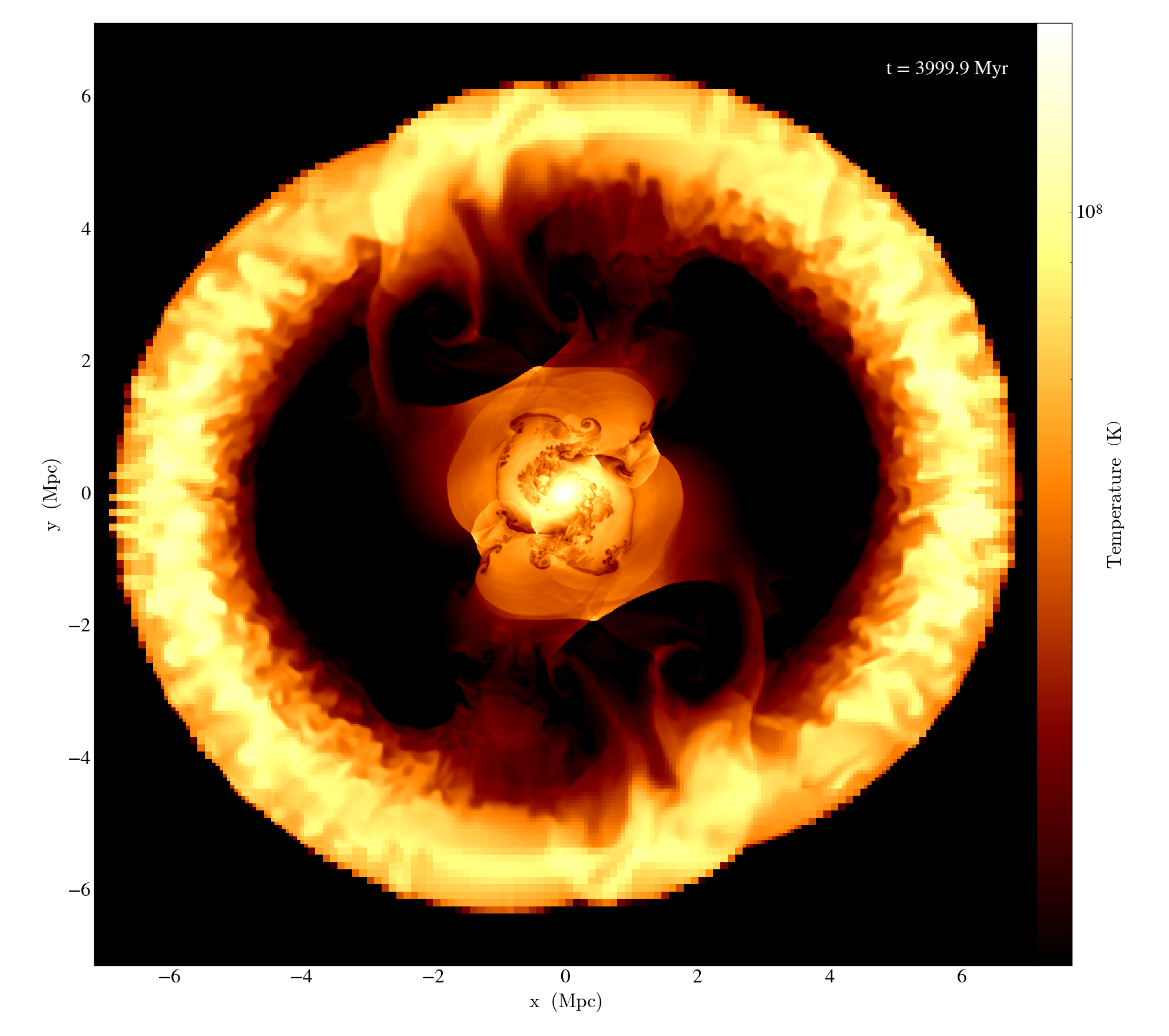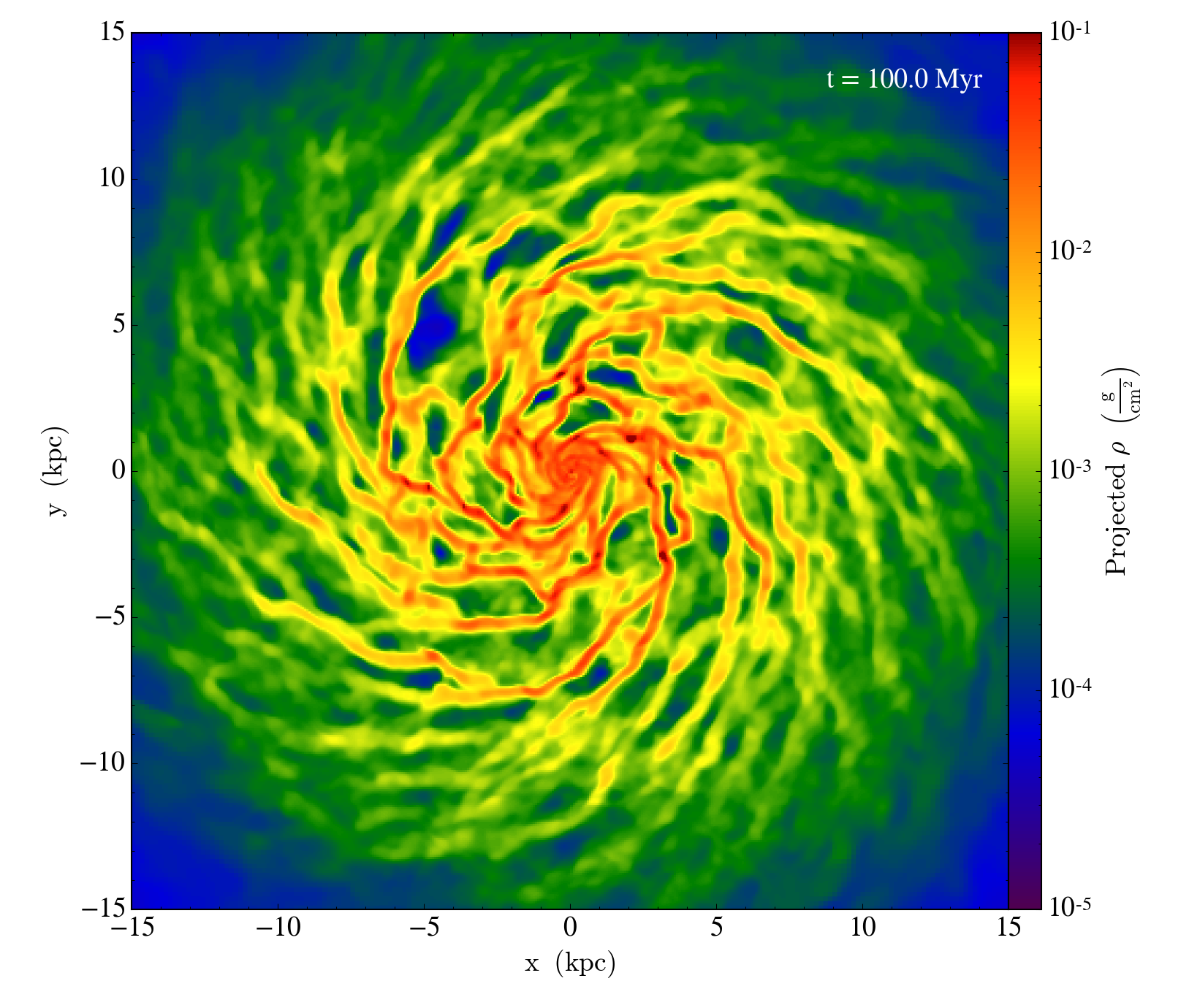GAMER is a GPU-accelerated Adaptive-MEsh-Refinement (AMR) code for astrophysics. It adopts a hybrid OpenMP/MPI/GPU parallelism model to utilize both CPU and GPU computing power and further takes advantage of the simultaneity between CPU computation, GPU computation, and CPU-GPU communication. GAMER has been demonstrated to achieve high parallel efficiency for both weak and strong scaling on Blue Waters using up to 4,096 GPUs and 65,536 CPU cores. It thus provides a unique numerical tool to study various astrophysical phenomena requiring resolutions that are not realistically attainable by other CPU-based AMR codes.


We have applied GAMER to several cutting-edge astrophysical simulations. For example, the left figure shows a merging galaxy clusters with a spatial resolution almost an order of magnitude higher than the previous work. This will allow astrophysicists, for the first time, to resolve the turbulence cascade in the intracluster medium on scales comparable to Chandra observations. The right figure shows an isolated disk galaxy simulation aiming for producing a dynamically evolving interstellar medium, undergoing repeated cycles of collapse, star formation, feedback, rarefaction, and re-collapse which have not been fully resolved previously in a global galactic scale simulation.
Project Members: Hsi-Yu Schive, Matthew Turk, Nathan Goldbaum
Collaborators: John ZuHone (Harvard-Smithsonian Center for Astrophysics)
Publications:
1465195
6DCKJATC
items
1
0
author
asc
504
https://gravity.ncsa.illinois.edu/wp-content/plugins/zotpress/
%7B%22status%22%3A%22success%22%2C%22updateneeded%22%3Afalse%2C%22instance%22%3A%22zotpress-544bf4fb8a3b4924eb604e8460ceeca9%22%2C%22meta%22%3A%7B%22request_last%22%3A0%2C%22request_next%22%3A0%2C%22used_cache%22%3Atrue%7D%2C%22data%22%3A%5B%7B%22key%22%3A%227S8NYGLZ%22%2C%22library%22%3A%7B%22id%22%3A1465195%7D%2C%22meta%22%3A%7B%22creatorSummary%22%3A%22Chan%20et%20al.%22%2C%22parsedDate%22%3A%222018-08-01%22%2C%22numChildren%22%3A3%7D%2C%22bib%22%3A%22%3Cdiv%20class%3D%5C%22csl-bib-body%5C%22%20style%3D%5C%22line-height%3A%202%3B%20padding-left%3A%201em%3B%20text-indent%3A-1em%3B%5C%22%3E%5Cn%20%20%3Cdiv%20class%3D%5C%22csl-entry%5C%22%3EChan%2C%20J.%20H.%20H.%2C%20Schive%2C%20H.-Y.%2C%20Woo%2C%20T.-P.%2C%20%26amp%3B%20Chiueh%2C%20T.%20%282018%29.%20How%20do%20stars%20affect%20%24%5C%5Cpsi%24DM%20halos%3F%20%3Ci%3EMonthly%20Notices%20of%20the%20Royal%20Astronomical%20Society%3C%5C%2Fi%3E%2C%20%3Ci%3E478%3C%5C%2Fi%3E%282%29%2C%202686%26%23x2013%3B2699.%20%3Ca%20href%3D%27https%3A%5C%2F%5C%2Fdoi.org%5C%2F10.1093%5C%2Fmnras%5C%2Fsty900%27%3Ehttps%3A%5C%2F%5C%2Fdoi.org%5C%2F10.1093%5C%2Fmnras%5C%2Fsty900%3C%5C%2Fa%3E%3C%5C%2Fdiv%3E%5Cn%3C%5C%2Fdiv%3E%22%2C%22data%22%3A%7B%22itemType%22%3A%22journalArticle%22%2C%22title%22%3A%22How%20do%20stars%20affect%20%24%5C%5Cpsi%24DM%20halos%3F%22%2C%22creators%22%3A%5B%7B%22creatorType%22%3A%22author%22%2C%22firstName%22%3A%22James%20H.%20H.%22%2C%22lastName%22%3A%22Chan%22%7D%2C%7B%22creatorType%22%3A%22author%22%2C%22firstName%22%3A%22Hsi-Yu%22%2C%22lastName%22%3A%22Schive%22%7D%2C%7B%22creatorType%22%3A%22author%22%2C%22firstName%22%3A%22Tak-Pong%22%2C%22lastName%22%3A%22Woo%22%7D%2C%7B%22creatorType%22%3A%22author%22%2C%22firstName%22%3A%22Tzihong%22%2C%22lastName%22%3A%22Chiueh%22%7D%5D%2C%22abstractNote%22%3A%22Wave%20dark%20matter%20%28%24%5C%5Cpsi%24DM%29%20predicts%20a%20compact%20soliton%20core%20and%20a%20granular%20halo%20in%20every%20galaxy.%20This%20work%20presents%20the%20first%20simulation%20study%20of%20an%20elliptical%20galaxy%20by%20including%20both%20stars%20and%20%24%5C%5Cpsi%24DM%2C%20focusing%20on%20the%20systematic%20changes%20of%20the%20central%20soliton%20and%20halo%20granules.%20With%20the%20addition%20of%20stars%20in%20the%20inner%20halo%2C%20we%20find%20the%20soliton%20core%20consistently%20becomes%20more%20prominent%20by%20absorbing%20mass%20from%20the%20host%20halo%20than%20that%20without%20stars%2C%20and%20the%20halo%20granules%20become%20%5C%22non-isothermal%5C%22%2C%20%5C%22hotter%5C%22%20in%20the%20inner%20halo%20and%20%5C%22cooler%5C%22%20in%20the%20outer%20halo%2C%20as%20opposed%20to%20the%20isothermal%20halo%20in%20pure%20%24%5C%5Cpsi%24DM%20cosmological%20simulations.%20Moreover%2C%20the%20composite%20%28star%2B%24%5C%5Cpsi%24DM%29%20mass%20density%20is%20found%20to%20follow%20a%20%24r%5E%7B-2%7D%24%20isothermal%20profile%20near%20the%20half-light%20radius%20in%20most%20cases.%20Most%20striking%20is%20the%20velocity%20dispersion%20of%20halo%20stars%20that%20increases%20rapidly%20toward%20the%20galactic%20center%20by%20a%20factor%20of%20at%20least%202%20inside%20the%20half-light%20radius%20caused%20by%20the%20deepened%20soliton%20gravitational%20potential%2C%20a%20result%20that%20compares%20favorably%20with%20observations%20of%20elliptical%20galaxies%20and%20bulges%20in%20spiral%20galaxies.%20However%20in%20some%20rare%20situations%20we%20find%20a%20phase%20segregation%20turning%20a%20compact%20distribution%20of%20stars%20into%20two%20distinct%20populations%20with%20high%20and%20very%20low%20velocity%20dispersions%3B%20while%20the%20high-velocity%20component%20mostly%20resides%20in%20the%20halo%2C%20the%20very%20low-velocity%20component%20is%20bound%20to%20the%20interior%20of%20the%20soliton%20core%2C%20resembling%20stars%20in%20faint%20dwarf%20spheroidal%20galaxies.%22%2C%22date%22%3A%222018-08-01%22%2C%22language%22%3A%22%22%2C%22DOI%22%3A%2210.1093%5C%2Fmnras%5C%2Fsty900%22%2C%22ISSN%22%3A%220035-8711%2C%201365-2966%22%2C%22url%22%3A%22http%3A%5C%2F%5C%2Farxiv.org%5C%2Fabs%5C%2F1712.01947%22%2C%22collections%22%3A%5B%22FV6JEWFF%22%2C%226DCKJATC%22%5D%2C%22dateModified%22%3A%222018-07-08T18%3A56%3A05Z%22%7D%7D%2C%7B%22key%22%3A%22JVUMEVN5%22%2C%22library%22%3A%7B%22id%22%3A1465195%7D%2C%22meta%22%3A%7B%22creatorSummary%22%3A%22Chen%20et%20al.%22%2C%22parsedDate%22%3A%222017%22%2C%22numChildren%22%3A3%7D%2C%22bib%22%3A%22%3Cdiv%20class%3D%5C%22csl-bib-body%5C%22%20style%3D%5C%22line-height%3A%202%3B%20padding-left%3A%201em%3B%20text-indent%3A-1em%3B%5C%22%3E%5Cn%20%20%3Cdiv%20class%3D%5C%22csl-entry%5C%22%3EChen%2C%20S.-R.%2C%20Schive%2C%20H.-Y.%2C%20%26amp%3B%20Chiueh%2C%20T.%20%282017%29.%20Jeans%20Analysis%20for%20Dwarf%20Spheroidal%20Galaxies%20in%20Wave%20Dark%20Matter.%20%3Ci%3EMonthly%20Notices%20of%20the%20Royal%20Astronomical%20Society%3C%5C%2Fi%3E%2C%20%3Ci%3E468%3C%5C%2Fi%3E%282%29%2C%201338%26%23x2013%3B1348.%20%3Ca%20href%3D%27https%3A%5C%2F%5C%2Fdoi.org%5C%2F10.1093%5C%2Fmnras%5C%2Fstx449%27%3Ehttps%3A%5C%2F%5C%2Fdoi.org%5C%2F10.1093%5C%2Fmnras%5C%2Fstx449%3C%5C%2Fa%3E%3C%5C%2Fdiv%3E%5Cn%3C%5C%2Fdiv%3E%22%2C%22data%22%3A%7B%22itemType%22%3A%22journalArticle%22%2C%22title%22%3A%22Jeans%20Analysis%20for%20Dwarf%20Spheroidal%20Galaxies%20in%20Wave%20Dark%20Matter%22%2C%22creators%22%3A%5B%7B%22creatorType%22%3A%22author%22%2C%22firstName%22%3A%22Shu-Rong%22%2C%22lastName%22%3A%22Chen%22%7D%2C%7B%22creatorType%22%3A%22author%22%2C%22firstName%22%3A%22Hsi-Yu%22%2C%22lastName%22%3A%22Schive%22%7D%2C%7B%22creatorType%22%3A%22author%22%2C%22firstName%22%3A%22Tzihong%22%2C%22lastName%22%3A%22Chiueh%22%7D%5D%2C%22abstractNote%22%3A%22Although%20still%20under%20debate%2C%20observations%20generally%20suggest%20that%20dwarf%20spheroidal%20%28dSph%29%20galaxies%20exhibit%20large%20constant-density%20cores%20in%20the%20centers%2C%20which%20can%20hardly%20be%20explained%20by%20dissipationless%20cold%20dark%20matter%20simulations%20without%20baryonic%20feedback.%20Wave%20dark%20matter%20%28%24%7B%5C%5Cpsi%20%7B%5C%5Crm%20DM%7D%7D%24%29%2C%20characterized%20by%20a%20single%20parameter%2C%20the%20dark%20matter%20particle%20mass%20%24m_%7B%5C%5Cpsi%7D%24%2C%20predicts%20a%20central%20soliton%20core%20in%20every%20galaxy%20arising%20from%20quantum%20pressure%20against%20gravity.%20Here%20we%20apply%20Jeans%20analysis%20assuming%20a%20soliton%20core%20profile%20to%20the%20kinematic%20data%20of%20eight%20classical%20dSphs%20so%20as%20to%20constrain%20%24m_%7B%5C%5Cpsi%7D%24%2C%20and%20obtain%20%24m_%7B%5C%5Cpsi%7D%3D1.18_%7B-0.24%7D%5E%7B%2B0.28%7D%5C%5Ctimes10%5E%7B-22%7D%7B%5C%5C%2C%5C%5Crm%20eV%7D%24%20and%20%24m_%7B%5C%5Cpsi%7D%3D1.79_%7B-0.33%7D%5E%7B%2B0.35%7D%5C%5Ctimes10%5E%7B-22%7D%7B%5C%5C%2C%5C%5Crm%20eV%7D~%282%5C%5Csigma%29%24%20using%20the%20observational%20data%20sets%20of%20Walker%20et%20al.%20%282007%29%20and%20Walker%20et%20al.%20%282009b%29%2C%20respectively.%20We%20show%20that%20the%20estimate%20of%20%24m_%7B%5C%5Cpsi%7D%24%20is%20sensitive%20to%20the%20dSphs%20kinematic%20data%20sets%20and%20is%20robust%20to%20various%20models%20of%20stellar%20density%20profile.%20We%20also%20consider%20multiple%20stellar%20subpopulations%20in%20dSphs%20and%20find%20consistent%20results.%20This%20mass%20range%20of%20%24m_%7B%5C%5Cpsi%7D%24%20is%20in%20good%20agreement%20with%20other%20independent%20estimates%2C%20such%20as%20the%20high-redshift%20luminosity%20functions%2C%20the%20reionization%20history%2C%20and%20the%20Thomson%20optical%20depth%20to%20the%20cosmic%20microwave%20background.%22%2C%22date%22%3A%2206%5C%2F2017%22%2C%22language%22%3A%22%22%2C%22DOI%22%3A%2210.1093%5C%2Fmnras%5C%2Fstx449%22%2C%22ISSN%22%3A%220035-8711%2C%201365-2966%22%2C%22url%22%3A%22http%3A%5C%2F%5C%2Farxiv.org%5C%2Fabs%5C%2F1606.09030%22%2C%22collections%22%3A%5B%22FV6JEWFF%22%2C%226DCKJATC%22%5D%2C%22dateModified%22%3A%222018-07-08T18%3A56%3A28Z%22%7D%7D%2C%7B%22key%22%3A%22YNGRSTXB%22%2C%22library%22%3A%7B%22id%22%3A1465195%7D%2C%22meta%22%3A%7B%22creatorSummary%22%3A%22De%20Martino%20et%20al.%22%2C%22parsedDate%22%3A%222017-11-29%22%2C%22numChildren%22%3A3%7D%2C%22bib%22%3A%22%3Cdiv%20class%3D%5C%22csl-bib-body%5C%22%20style%3D%5C%22line-height%3A%202%3B%20padding-left%3A%201em%3B%20text-indent%3A-1em%3B%5C%22%3E%5Cn%20%20%3Cdiv%20class%3D%5C%22csl-entry%5C%22%3EDe%20Martino%2C%20I.%2C%20Broadhurst%2C%20T.%2C%20Tye%2C%20S.-H.%20H.%2C%20Chiueh%2C%20T.%2C%20Schive%2C%20H.-Y.%2C%20%26amp%3B%20Lazkoz%2C%20R.%20%282017%29.%20Recognising%20Axionic%20Dark%20Matter%20by%20Compton%20and%20de-Broglie%20Scale%20Modulation%20of%20Pulsar%20Timing.%20%3Ci%3EPhysical%20Review%20Letters%3C%5C%2Fi%3E%2C%20%3Ci%3E119%3C%5C%2Fi%3E%2822%29.%20%3Ca%20href%3D%27https%3A%5C%2F%5C%2Fdoi.org%5C%2F10.1103%5C%2FPhysRevLett.119.221103%27%3Ehttps%3A%5C%2F%5C%2Fdoi.org%5C%2F10.1103%5C%2FPhysRevLett.119.221103%3C%5C%2Fa%3E%3C%5C%2Fdiv%3E%5Cn%3C%5C%2Fdiv%3E%22%2C%22data%22%3A%7B%22itemType%22%3A%22journalArticle%22%2C%22title%22%3A%22Recognising%20Axionic%20Dark%20Matter%20by%20Compton%20and%20de-Broglie%20Scale%20Modulation%20of%20Pulsar%20Timing%22%2C%22creators%22%3A%5B%7B%22creatorType%22%3A%22author%22%2C%22firstName%22%3A%22Ivan%22%2C%22lastName%22%3A%22De%20Martino%22%7D%2C%7B%22creatorType%22%3A%22author%22%2C%22firstName%22%3A%22Tom%22%2C%22lastName%22%3A%22Broadhurst%22%7D%2C%7B%22creatorType%22%3A%22author%22%2C%22firstName%22%3A%22S.-H.%20Henry%22%2C%22lastName%22%3A%22Tye%22%7D%2C%7B%22creatorType%22%3A%22author%22%2C%22firstName%22%3A%22Tzihong%22%2C%22lastName%22%3A%22Chiueh%22%7D%2C%7B%22creatorType%22%3A%22author%22%2C%22firstName%22%3A%22Hsi-Yu%22%2C%22lastName%22%3A%22Schive%22%7D%2C%7B%22creatorType%22%3A%22author%22%2C%22firstName%22%3A%22Ruth%22%2C%22lastName%22%3A%22Lazkoz%22%7D%5D%2C%22abstractNote%22%3A%22Light%20Axionic%20Dark%20Matter%2C%20motivated%20by%20string%20theory%2C%20is%20increasingly%20favored%20for%20the%20%5C%22no-WIMP%20era%5C%22.%20Galaxy%20formation%20is%20suppressed%20below%20a%20Jeans%20scale%2C%20of%20%24%5C%5Csimeq%2010%5E8%20M_%5C%5Codot%24%20by%20setting%20the%20axion%20mass%20to%2C%20%24m_B%20%5C%5Csim%2010%5E%7B-22%7D%24eV%2C%20and%20the%20large%20dark%20cores%20of%20dwarf%20galaxies%20are%20explained%20as%20solitons%20on%20the%20de-Broglie%20scale.%20This%20is%20persuasive%2C%20but%20detection%20of%20the%20inherent%20scalar%20field%20oscillation%20at%20the%20Compton%20frequency%2C%20%24%5C%5Comega_B%3D%20%282.5%7B%5C%5Crm%20%5C%5C%2C%20months%7D%29%5E%7B-1%7D%28m_B%5C%2F10%5E%7B-22%7DeV%29%24%2C%20would%20be%20definitive.%20By%20evolving%20the%20coupled%20Schr%5C%5C%5C%22odinger-Poisson%20equation%20for%20a%20Bose-Einstein%20condensate%2C%20we%20predict%20the%20dark%20matter%20is%20fully%20modulated%20by%20de-Broglie%20interference%2C%20with%20a%20dense%20soliton%20core%20of%20size%20%24%5C%5Csimeq%20150pc%24%2C%20at%20the%20Galactic%20center.%20The%20oscillating%20field%20pressure%20induces%20General%20Relativistic%20time%20dilation%20in%20proportion%20to%20the%20local%20dark%20matter%20density%20and%20pulsars%20within%20this%20dense%20core%20have%20detectably%20large%20timing%20residuals%2C%20of%20%24%5C%5Csimeq%20400nsec%5C%2F%28m_B%5C%2F10%5E%7B-22%7DeV%29%24.%20This%20is%20encouraging%20as%20many%20new%20pulsars%20should%20be%20discovered%20near%20the%20Galactic%20center%20with%20planned%20radio%20surveys.%20More%20generally%2C%20over%20the%20whole%20Galaxy%2C%20differences%20in%20dark%20matter%20density%20between%20pairs%20of%20pulsars%20imprints%20a%20pairwise%20Galactocentric%20signature%20that%20can%20be%20distinguished%20from%20an%20isotropic%20gravitational%20wave%20background.%22%2C%22date%22%3A%222017-11-29%22%2C%22language%22%3A%22%22%2C%22DOI%22%3A%2210.1103%5C%2FPhysRevLett.119.221103%22%2C%22ISSN%22%3A%220031-9007%2C%201079-7114%22%2C%22url%22%3A%22http%3A%5C%2F%5C%2Farxiv.org%5C%2Fabs%5C%2F1705.04367%22%2C%22collections%22%3A%5B%22FV6JEWFF%22%2C%226DCKJATC%22%5D%2C%22dateModified%22%3A%222018-07-08T18%3A56%3A17Z%22%7D%7D%2C%7B%22key%22%3A%226SGBLQ43%22%2C%22library%22%3A%7B%22id%22%3A1465195%7D%2C%22meta%22%3A%7B%22creatorSummary%22%3A%22Leung%20et%20al.%22%2C%22parsedDate%22%3A%222018-06-20%22%2C%22numChildren%22%3A3%7D%2C%22bib%22%3A%22%3Cdiv%20class%3D%5C%22csl-bib-body%5C%22%20style%3D%5C%22line-height%3A%202%3B%20padding-left%3A%201em%3B%20text-indent%3A-1em%3B%5C%22%3E%5Cn%20%20%3Cdiv%20class%3D%5C%22csl-entry%5C%22%3ELeung%2C%20E.%2C%20Broadhurst%2C%20T.%2C%20Lim%2C%20J.%2C%20Diego%2C%20J.%20M.%2C%20Chiueh%2C%20T.%2C%20Schive%2C%20H.-Y.%2C%20%26amp%3B%20Windhorst%2C%20R.%20%282018%29.%20Magnification%20Bias%20of%20Distant%20Galaxies%20in%20the%20Hubble%20Frontier%20Fields%3A%20Testing%20Wave%20vs.%20Particle%20Dark%20Matter%20Predictions.%20%3Ci%3EArXiv%3A1806.07905%20%5BAstro-Ph%5D%3C%5C%2Fi%3E.%20%3Ca%20href%3D%27http%3A%5C%2F%5C%2Farxiv.org%5C%2Fabs%5C%2F1806.07905%27%3Ehttp%3A%5C%2F%5C%2Farxiv.org%5C%2Fabs%5C%2F1806.07905%3C%5C%2Fa%3E%3C%5C%2Fdiv%3E%5Cn%3C%5C%2Fdiv%3E%22%2C%22data%22%3A%7B%22itemType%22%3A%22journalArticle%22%2C%22title%22%3A%22Magnification%20Bias%20of%20Distant%20Galaxies%20in%20the%20Hubble%20Frontier%20Fields%3A%20Testing%20Wave%20vs.%20Particle%20Dark%20Matter%20Predictions%22%2C%22creators%22%3A%5B%7B%22creatorType%22%3A%22author%22%2C%22firstName%22%3A%22Enoch%22%2C%22lastName%22%3A%22Leung%22%7D%2C%7B%22creatorType%22%3A%22author%22%2C%22firstName%22%3A%22Tom%22%2C%22lastName%22%3A%22Broadhurst%22%7D%2C%7B%22creatorType%22%3A%22author%22%2C%22firstName%22%3A%22Jeremy%22%2C%22lastName%22%3A%22Lim%22%7D%2C%7B%22creatorType%22%3A%22author%22%2C%22firstName%22%3A%22Jose%20M.%22%2C%22lastName%22%3A%22Diego%22%7D%2C%7B%22creatorType%22%3A%22author%22%2C%22firstName%22%3A%22Tzihong%22%2C%22lastName%22%3A%22Chiueh%22%7D%2C%7B%22creatorType%22%3A%22author%22%2C%22firstName%22%3A%22Hsi-Yu%22%2C%22lastName%22%3A%22Schive%22%7D%2C%7B%22creatorType%22%3A%22author%22%2C%22firstName%22%3A%22Rogier%22%2C%22lastName%22%3A%22Windhorst%22%7D%5D%2C%22abstractNote%22%3A%22Acting%20as%20powerful%20gravitational%20lenses%2C%20the%20strong%20lensing%20galaxy%20clusters%20of%20the%20deep%20%7B%5C%5Cit%20Hubble%7D%20Frontier%20Fields%20%28HFF%29%20program%20permit%20access%20to%20lower-luminosity%20galaxies%20lying%20at%20higher%20redshifts%20than%20hitherto%20possible.%20We%20analyzed%20the%20HFF%20to%20measure%20the%20volume%20density%20of%20Lyman-break%20galaxies%20at%20%24z%20%3E%204.75%24%20by%20identifying%20a%20complete%20and%20reliable%20sample%20up%20to%20%24z%20%5C%5Csimeq%2010%24.%20A%20marked%20deficit%20of%20such%20galaxies%20was%20uncovered%20in%20the%20highly%20magnified%20regions%20of%20the%20clusters%20relative%20to%20their%20outskirts%2C%20implying%20that%20the%20magnification%20of%20the%20sky%20area%20dominates%20over%20additional%20faint%20galaxies%20magnified%20above%20the%20flux%20limit.%20This%20negative%20magnification%20bias%20is%20consistent%20with%20a%20slow%20rollover%20at%20the%20faint%20end%20of%20the%20UV%20luminosity%20function%2C%20and%20indicates%20a%20preference%20for%20Bose-Einstein%20condensate%20dark%20matter%20with%20a%20light%20boson%20mass%20of%20%24m_%5C%5Cmathrm%7BB%7D%20%5C%5Csimeq%2010%5E%7B-22%7D%20%5C%5C%2C%20%5C%5Cmathrm%7BeV%7D%24%20over%20standard%20cold%20dark%20matter.%20We%20emphasize%20that%20measuring%20the%20magnification%20bias%20requires%20no%20correction%20for%20multiply%20lensed%20images%20%28with%20typically%20three%20or%20more%20images%20per%20source%29%2C%20whereas%20directly%20reconstructing%20the%20luminosity%20function%20will%20lead%20to%20an%20overestimate%20unless%20such%20images%20can%20be%20exhaustively%20matched%20up%2C%20especially%20at%20the%20faint%20end%20that%20is%20accessible%20only%20in%20the%20strongly%20lensed%20regions.%20In%20addition%2C%20we%20detected%20a%20distinctive%20downward%20transition%20in%20galaxy%20number%20density%20at%20%24z%20%5C%5Cgtrsim%208%24%2C%20which%20may%20be%20linked%20to%20the%20relatively%20late%20reionization%20reported%20by%20%7B%5C%5Cit%20Planck%7D.%20Our%20results%20suggests%20that%20%7B%5C%5Cit%20JWST%7D%20will%20likely%20peer%20into%20an%20%5C%22abyss%5C%22%20with%20essentially%20no%20galaxies%20detected%20in%20deep%20NIR%20imaging%20at%20%24z%20%3E%2010%24.%22%2C%22date%22%3A%222018-06-20%22%2C%22language%22%3A%22%22%2C%22DOI%22%3A%22%22%2C%22ISSN%22%3A%22%22%2C%22url%22%3A%22http%3A%5C%2F%5C%2Farxiv.org%5C%2Fabs%5C%2F1806.07905%22%2C%22collections%22%3A%5B%22FV6JEWFF%22%2C%226DCKJATC%22%5D%2C%22dateModified%22%3A%222018-07-08T18%3A55%3A44Z%22%7D%7D%2C%7B%22key%22%3A%22M3EXVNUA%22%2C%22library%22%3A%7B%22id%22%3A1465195%7D%2C%22meta%22%3A%7B%22creatorSummary%22%3A%22Lin%20et%20al.%22%2C%22parsedDate%22%3A%222018-05-23%22%2C%22numChildren%22%3A3%7D%2C%22bib%22%3A%22%3Cdiv%20class%3D%5C%22csl-bib-body%5C%22%20style%3D%5C%22line-height%3A%202%3B%20padding-left%3A%201em%3B%20text-indent%3A-1em%3B%5C%22%3E%5Cn%20%20%3Cdiv%20class%3D%5C%22csl-entry%5C%22%3ELin%2C%20S.-C.%2C%20Schive%2C%20H.-Y.%2C%20Wong%2C%20S.-K.%2C%20%26amp%3B%20Chiueh%2C%20T.%20%282018%29.%20Self-consistent%20construction%20of%20virialized%20wave%20dark%20matter%20halos.%20%3Ci%3EPhysical%20Review%20D%3C%5C%2Fi%3E%2C%20%3Ci%3E97%3C%5C%2Fi%3E%2810%29.%20%3Ca%20href%3D%27https%3A%5C%2F%5C%2Fdoi.org%5C%2F10.1103%5C%2FPhysRevD.97.103523%27%3Ehttps%3A%5C%2F%5C%2Fdoi.org%5C%2F10.1103%5C%2FPhysRevD.97.103523%3C%5C%2Fa%3E%3C%5C%2Fdiv%3E%5Cn%3C%5C%2Fdiv%3E%22%2C%22data%22%3A%7B%22itemType%22%3A%22journalArticle%22%2C%22title%22%3A%22Self-consistent%20construction%20of%20virialized%20wave%20dark%20matter%20halos%22%2C%22creators%22%3A%5B%7B%22creatorType%22%3A%22author%22%2C%22firstName%22%3A%22Shan-Chang%22%2C%22lastName%22%3A%22Lin%22%7D%2C%7B%22creatorType%22%3A%22author%22%2C%22firstName%22%3A%22Hsi-Yu%22%2C%22lastName%22%3A%22Schive%22%7D%2C%7B%22creatorType%22%3A%22author%22%2C%22firstName%22%3A%22Shing-Kwong%22%2C%22lastName%22%3A%22Wong%22%7D%2C%7B%22creatorType%22%3A%22author%22%2C%22firstName%22%3A%22Tzihong%22%2C%22lastName%22%3A%22Chiueh%22%7D%5D%2C%22abstractNote%22%3A%22Wave%20dark%20matter%20%28%24%5C%5Cpsi%24DM%29%2C%20which%20satisfies%20the%20Schr%5C%5C%5C%22odinger-Poisson%20equation%2C%20has%20recently%20attracted%20substantial%20attention%20as%20a%20possible%20dark%20matter%20candidate.%20Numerical%20simulations%20have%20in%20the%20past%20provided%20a%20powerful%20tool%20to%20explore%20this%20new%20territory%20of%20possibility.%20Despite%20their%20successes%20to%20reveal%20several%20key%20features%20of%20%24%5C%5Cpsi%24DM%2C%20further%20progress%20in%20simulations%20is%20limited%2C%20in%20that%20cosmological%20simulations%20so%20far%20can%20only%20address%20formation%20of%20halos%20below%20%24%5C%5Csim%202%5C%5Ctimes%2010%5E%7B11%7D%20M_%5C%5Codot%24%20and%20substantially%20more%20massive%20halos%20have%20become%20computationally%20very%20challenging%20to%20obtain.%20For%20this%20reason%2C%20the%20present%20work%20adopts%20a%20different%20approach%20in%20assessing%20massive%20halos%20by%20constructing%20wave-halo%20solutions%20directly%20from%20the%20wave%20distribution%20function.%20This%20approach%20bears%20certain%20similarity%20with%20the%20analytical%20construction%20of%20particle-halo%20%28cold%20dark%20matter%20model%29.%20Instead%20of%20many%20collisionless%20particles%2C%20one%20deals%20with%20one%20single%20wave%20that%20has%20many%20non-interacting%20eigenstates.%20The%20key%20ingredient%20in%20the%20wave-halo%20construction%20is%20the%20distribution%20function%20of%20the%20wave%20power%2C%20and%20we%20use%20several%20halos%20produced%20by%20structure%20formation%20simulations%20as%20templates%20to%20determine%20the%20wave%20distribution%20function.%20Among%20different%20models%2C%20we%20find%20the%20fermionic%20King%20model%20presents%20the%20best%20fits%20and%20we%20use%20it%20for%20our%20wave-halo%20construction.%20We%20have%20devised%20an%20iteration%20method%20for%20constructing%20the%20nonlinear%20halo%2C%20and%20demonstrate%20its%20stability%20by%20three-dimensional%20simulations.%20A%20Milky-Way-sized%20halo%20has%20also%20been%20constructed%2C%20and%20the%20inner%20halo%20is%20found%20flatter%20than%20the%20NFW%20profile.%20These%20wave-halos%20have%20small-scale%20interferences%20both%20in%20space%20and%20time%20producing%20time-dependent%20granules.%20While%20the%20spatial%20scale%20of%20granules%20varies%20little%2C%20the%20correlation%20time%20is%20found%20to%20increase%20with%20radius%20by%20one%20order%20of%20magnitude%20across%20the%20halo.%22%2C%22date%22%3A%222018-5-23%22%2C%22language%22%3A%22%22%2C%22DOI%22%3A%2210.1103%5C%2FPhysRevD.97.103523%22%2C%22ISSN%22%3A%222470-0010%2C%202470-0029%22%2C%22url%22%3A%22http%3A%5C%2F%5C%2Farxiv.org%5C%2Fabs%5C%2F1801.02320%22%2C%22collections%22%3A%5B%22FV6JEWFF%22%2C%226DCKJATC%22%5D%2C%22dateModified%22%3A%222018-07-08T18%3A55%3A57Z%22%7D%7D%2C%7B%22key%22%3A%2252VUAF2I%22%2C%22library%22%3A%7B%22id%22%3A1465195%7D%2C%22meta%22%3A%7B%22creatorSummary%22%3A%22Molnar%20et%20al.%22%2C%22parsedDate%22%3A%222017%22%2C%22numChildren%22%3A1%7D%2C%22bib%22%3A%22%3Cdiv%20class%3D%5C%22csl-bib-body%5C%22%20style%3D%5C%22line-height%3A%202%3B%20padding-left%3A%201em%3B%20text-indent%3A-1em%3B%5C%22%3E%5Cn%20%20%3Cdiv%20class%3D%5C%22csl-entry%5C%22%3EMolnar%2C%20S.%20M.%2C%20Schive%2C%20H.-Y.%2C%20Birkinshaw%2C%20M.%2C%20Chiueh%2C%20T.%2C%20Musoke%2C%20G.%2C%20%26amp%3B%20Young%2C%20A.%20J.%20%282017%29.%20Hydrodynamical%20Simulations%20of%20Colliding%20Jets%3A%20Modeling%203C%2075.%20%3Ci%3EThe%20Astrophysical%20Journal%3C%5C%2Fi%3E%2C%20%3Ci%3E835%3C%5C%2Fi%3E%281%29%2C%2057.%20%3Ca%20href%3D%27https%3A%5C%2F%5C%2Fdoi.org%5C%2F10.3847%5C%2F1538-4357%5C%2F835%5C%2F1%5C%2F57%27%3Ehttps%3A%5C%2F%5C%2Fdoi.org%5C%2F10.3847%5C%2F1538-4357%5C%2F835%5C%2F1%5C%2F57%3C%5C%2Fa%3E%3C%5C%2Fdiv%3E%5Cn%3C%5C%2Fdiv%3E%22%2C%22data%22%3A%7B%22itemType%22%3A%22journalArticle%22%2C%22title%22%3A%22Hydrodynamical%20Simulations%20of%20Colliding%20Jets%3A%20Modeling%203C%2075%22%2C%22creators%22%3A%5B%7B%22creatorType%22%3A%22author%22%2C%22firstName%22%3A%22S.%20M.%22%2C%22lastName%22%3A%22Molnar%22%7D%2C%7B%22creatorType%22%3A%22author%22%2C%22firstName%22%3A%22H.-Y.%22%2C%22lastName%22%3A%22Schive%22%7D%2C%7B%22creatorType%22%3A%22author%22%2C%22firstName%22%3A%22M.%22%2C%22lastName%22%3A%22Birkinshaw%22%7D%2C%7B%22creatorType%22%3A%22author%22%2C%22firstName%22%3A%22T.%22%2C%22lastName%22%3A%22Chiueh%22%7D%2C%7B%22creatorType%22%3A%22author%22%2C%22firstName%22%3A%22G.%22%2C%22lastName%22%3A%22Musoke%22%7D%2C%7B%22creatorType%22%3A%22author%22%2C%22firstName%22%3A%22A.%20J.%22%2C%22lastName%22%3A%22Young%22%7D%5D%2C%22abstractNote%22%3A%22Radio%20observations%20suggest%20that%203C%2075%2C%20located%20in%20the%20dumbbell%20shaped%20galaxy%20NGC%201128%20at%20the%20center%20of%20Abell%20400%2C%20hosts%20two%20colliding%20jets.%20Motivated%20by%20this%20source%2C%20we%20perform%20three-dimensional%20hydrodynamical%20simulations%20using%20a%20modified%20version%20of%20the%20GPU-accelerated%20Adaptive-MEsh-Refinement%20hydrodynamical%20parallel%20code%20%28%20GAMER%20%29%20to%20study%20colliding%20extragalactic%20jets.%20We%20find%20that%20colliding%20jets%20can%20be%20cast%20into%20two%20categories%3A%20%281%29%20bouncing%20jets%2C%20in%20which%20case%20the%20jets%20bounce%20off%20each%20other%20keeping%20their%20identities%2C%20and%20%282%29%20merging%20jets%2C%20when%20only%20one%20jet%20emerges%20from%20the%20collision.%20Under%20some%20conditions%20the%20interaction%20causes%20the%20jets%20to%20break%20up%20into%20oscillating%20filaments%20of%20opposite%20helicity%2C%20with%20consequences%20for%20their%20downstream%20stability.%20When%20one%20jet%20is%20significantly%20faster%20than%20the%20other%20and%20the%20impact%20parameter%20is%20small%2C%20the%20jets%20merge%3B%20the%20faster%20jet%20takes%20over%20the%20slower%20one.%20In%20the%20case%20of%20merging%20jets%2C%20the%20oscillations%20of%20the%20filaments%2C%20in%20projection%2C%20may%20show%20a%20feature%20that%20resembles%20a%20double%20helix%2C%20similar%20to%20the%20radio%20image%20of%203C%2075.%20Thus%20we%20interpret%20the%20morphology%20of%203C%2075%20as%20a%20consequence%20of%20the%20collision%20of%20two%20jets%20with%20distinctly%20different%20speeds%20at%20a%20small%20impact%20parameter%2C%20with%20the%20faster%20jet%20breaking%20up%20into%20two%20oscillating%20filaments.%22%2C%22date%22%3A%222017%22%2C%22language%22%3A%22en%22%2C%22DOI%22%3A%2210.3847%5C%2F1538-4357%5C%2F835%5C%2F1%5C%2F57%22%2C%22ISSN%22%3A%220004-637X%22%2C%22url%22%3A%22http%3A%5C%2F%5C%2Fstacks.iop.org%5C%2F0004-637X%5C%2F835%5C%2Fi%3D1%5C%2Fa%3D57%22%2C%22collections%22%3A%5B%22FV6JEWFF%22%2C%226DCKJATC%22%5D%2C%22dateModified%22%3A%222017-07-12T14%3A25%3A30Z%22%7D%7D%2C%7B%22key%22%3A%22Z38L57HX%22%2C%22library%22%3A%7B%22id%22%3A1465195%7D%2C%22meta%22%3A%7B%22creatorSummary%22%3A%22Schive%20and%20Chiueh%22%2C%22parsedDate%22%3A%222018-01-01%22%2C%22numChildren%22%3A3%7D%2C%22bib%22%3A%22%3Cdiv%20class%3D%5C%22csl-bib-body%5C%22%20style%3D%5C%22line-height%3A%202%3B%20padding-left%3A%201em%3B%20text-indent%3A-1em%3B%5C%22%3E%5Cn%20%20%3Cdiv%20class%3D%5C%22csl-entry%5C%22%3ESchive%2C%20H.-Y.%2C%20%26amp%3B%20Chiueh%2C%20T.%20%282018%29.%20Halo%20Abundance%20and%20Assembly%20History%20with%20Extreme-Axion%20Wave%20Dark%20Matter%20at%20%24z%5C%5Cge%204%24.%20%3Ci%3EMonthly%20Notices%20of%20the%20Royal%20Astronomical%20Society%3A%20Letters%3C%5C%2Fi%3E%2C%20%3Ci%3E473%3C%5C%2Fi%3E%281%29%2C%20L36%26%23x2013%3BL40.%20%3Ca%20href%3D%27https%3A%5C%2F%5C%2Fdoi.org%5C%2F10.1093%5C%2Fmnrasl%5C%2Fslx159%27%3Ehttps%3A%5C%2F%5C%2Fdoi.org%5C%2F10.1093%5C%2Fmnrasl%5C%2Fslx159%3C%5C%2Fa%3E%3C%5C%2Fdiv%3E%5Cn%3C%5C%2Fdiv%3E%22%2C%22data%22%3A%7B%22itemType%22%3A%22journalArticle%22%2C%22title%22%3A%22Halo%20Abundance%20and%20Assembly%20History%20with%20Extreme-Axion%20Wave%20Dark%20Matter%20at%20%24z%5C%5Cge%204%24%22%2C%22creators%22%3A%5B%7B%22creatorType%22%3A%22author%22%2C%22firstName%22%3A%22Hsi-Yu%22%2C%22lastName%22%3A%22Schive%22%7D%2C%7B%22creatorType%22%3A%22author%22%2C%22firstName%22%3A%22Tzihong%22%2C%22lastName%22%3A%22Chiueh%22%7D%5D%2C%22abstractNote%22%3A%22Wave%20dark%20matter%20%28%24%5C%5Cpsi%20%5C%5Crm%7BDM%7D%24%29%20composed%20of%20extremely%20light%20bosons%20%28%24m_%7B%5C%5Cpsi%7D%20%5C%5Csim%2010%5E%7B-22%7D%5C%5C%2C%5C%5Crm%20eV%24%29%2C%20with%20quantum%20pressure%20suppressing%20structures%20below%20a%20kpc-scale%20de%20Broglie%20wavelength%2C%20has%20become%20a%20viable%20dark%20matter%20candidate.%20Compared%20to%20the%20conventional%20free-particle%20%24%5C%5Cpsi%20%7B%5C%5Crm%20DM%7D%24%20%28%24%7B%5C%5Crm%20FP%7D%20%5C%5Cpsi%20%7B%5C%5Crm%20DM%7D%24%29%2C%20the%20extreme-axion%20%24%5C%5Cpsi%20%5C%5Crm%7BDM%7D%24%20model%20%28%24%7B%5C%5Crm%20EA%7D%20%5C%5Cpsi%20%7B%5C%5Crm%20DM%7D%24%29%20proposed%20by%20Zhang%20%26%20Chiueh%20%282017%29%20features%20a%20larger%20cut-off%20wavenumber%20and%20a%20broad%20spectral%20bump%20in%20the%20matter%20transfer%20function.%20Here%20we%20conduct%20cosmological%20simulations%20to%20compare%20the%20halo%20abundances%20and%20assembly%20histories%20at%20%24z%3D4-11%24%20between%20three%20different%20scenarios%3A%20%24%7B%5C%5Crm%20FP%7D%20%5C%5Cpsi%20%7B%5C%5Crm%20DM%7D%24%2C%20%24%7B%5C%5Crm%20EA%7D%20%5C%5Cpsi%20%7B%5C%5Crm%20DM%7D%24%2C%20and%20cold%20dark%20matter%20%28CDM%29.%20We%20show%20that%20%24%7B%5C%5Crm%20EA%7D%20%5C%5Cpsi%20%7B%5C%5Crm%20DM%7D%24%20produces%20significantly%20more%20abundant%20low-mass%20haloes%20than%20%24%7B%5C%5Crm%20FP%7D%20%5C%5Cpsi%20%7B%5C%5Crm%20DM%7D%24%20with%20the%20same%20%24m_%7B%5C%5Cpsi%7D%24%2C%20and%20therefore%20could%20alleviate%20the%20tension%20in%20%24m_%7B%5C%5Cpsi%7D%24%20required%20by%20the%20Ly%24%5C%5Calpha%24%20forest%20data%20and%20by%20the%20kpc-scale%20dwarf%20galaxy%20cores.%20We%20also%20find%20that%2C%20compared%20to%20the%20CDM%20counterparts%2C%20massive%20%24%7B%5C%5Crm%20EA%7D%20%5C%5Cpsi%20%7B%5C%5Crm%20DM%7D%24%20haloes%20are%20on%20average%20%243-4%24%20times%20more%20massive%20at%20%24z%3D10-11%24%20due%20to%20their%20earlier%20formation%2C%20undergo%20a%20slower%20mass%20accretion%20at%20%247%20%5C%5Clesssim%20z%20%5C%5Clesssim%2011%24%2C%20and%20then%20show%20a%20rapidly%20rising%20major%20merger%20rate%20exceeding%20CDM%20by%20%24%5C%5Csim%2050%5C%5C%25%24%20at%20%244%20%5C%5Clesssim%20z%20%5C%5Clesssim%207%24.%20This%20fact%20suggests%20that%20%24%7B%5C%5Crm%20EA%7D%20%5C%5Cpsi%20%7B%5C%5Crm%20DM%7D%24%20haloes%20may%20exhibit%20more%20prominent%20starbursts%20at%20%24z%20%5C%5Clesssim%207%24.%22%2C%22date%22%3A%222018-01-01%22%2C%22language%22%3A%22%22%2C%22DOI%22%3A%2210.1093%5C%2Fmnrasl%5C%2Fslx159%22%2C%22ISSN%22%3A%221745-3925%2C%201745-3933%22%2C%22url%22%3A%22http%3A%5C%2F%5C%2Farxiv.org%5C%2Fabs%5C%2F1706.03723%22%2C%22collections%22%3A%5B%22FV6JEWFF%22%2C%226DCKJATC%22%5D%2C%22dateModified%22%3A%222018-07-08T18%3A56%3A10Z%22%7D%7D%2C%7B%22key%22%3A%22TXKYMQDK%22%2C%22library%22%3A%7B%22id%22%3A1465195%7D%2C%22meta%22%3A%7B%22creatorSummary%22%3A%22Schive%20et%20al.%22%2C%22parsedDate%22%3A%222017-12-19%22%2C%22numChildren%22%3A3%7D%2C%22bib%22%3A%22%3Cdiv%20class%3D%5C%22csl-bib-body%5C%22%20style%3D%5C%22line-height%3A%202%3B%20padding-left%3A%201em%3B%20text-indent%3A-1em%3B%5C%22%3E%5Cn%20%20%3Cdiv%20class%3D%5C%22csl-entry%5C%22%3ESchive%2C%20H.-Y.%2C%20ZuHone%2C%20J.%20A.%2C%20Goldbaum%2C%20N.%20J.%2C%20Turk%2C%20M.%20J.%2C%20Gaspari%2C%20M.%2C%20%26amp%3B%20Cheng%2C%20C.-Y.%20%282017%29.%20GAMER-2%3A%20a%20GPU-accelerated%20adaptive%20mesh%20refinement%20code%20--%20accuracy%2C%20performance%2C%20and%20scalability.%20%3Ci%3EArXiv%3A1712.07070%20%5BAstro-Ph%5D%3C%5C%2Fi%3E.%20%3Ca%20href%3D%27http%3A%5C%2F%5C%2Farxiv.org%5C%2Fabs%5C%2F1712.07070%27%3Ehttp%3A%5C%2F%5C%2Farxiv.org%5C%2Fabs%5C%2F1712.07070%3C%5C%2Fa%3E%3C%5C%2Fdiv%3E%5Cn%3C%5C%2Fdiv%3E%22%2C%22data%22%3A%7B%22itemType%22%3A%22journalArticle%22%2C%22title%22%3A%22GAMER-2%3A%20a%20GPU-accelerated%20adaptive%20mesh%20refinement%20code%20--%20accuracy%2C%20performance%2C%20and%20scalability%22%2C%22creators%22%3A%5B%7B%22creatorType%22%3A%22author%22%2C%22firstName%22%3A%22Hsi-Yu%22%2C%22lastName%22%3A%22Schive%22%7D%2C%7B%22creatorType%22%3A%22author%22%2C%22firstName%22%3A%22John%20A.%22%2C%22lastName%22%3A%22ZuHone%22%7D%2C%7B%22creatorType%22%3A%22author%22%2C%22firstName%22%3A%22Nathan%20J.%22%2C%22lastName%22%3A%22Goldbaum%22%7D%2C%7B%22creatorType%22%3A%22author%22%2C%22firstName%22%3A%22Matthew%20J.%22%2C%22lastName%22%3A%22Turk%22%7D%2C%7B%22creatorType%22%3A%22author%22%2C%22firstName%22%3A%22Massimo%22%2C%22lastName%22%3A%22Gaspari%22%7D%2C%7B%22creatorType%22%3A%22author%22%2C%22firstName%22%3A%22Chin-Yu%22%2C%22lastName%22%3A%22Cheng%22%7D%5D%2C%22abstractNote%22%3A%22We%20present%20GAMER-2%2C%20a%20GPU-accelerated%20adaptive%20mesh%20refinement%20%28AMR%29%20code%20for%20astrophysics.%20It%20provides%20a%20rich%20set%20of%20features%2C%20including%20adaptive%20time-stepping%2C%20several%20hydrodynamic%20schemes%2C%20magnetohydrodynamics%2C%20self-gravity%2C%20particles%2C%20star%20formation%2C%20chemistry%20and%20radiative%20processes%20with%20GRACKLE%2C%20data%20analysis%20with%20yt%2C%20and%20memory%20pool%20for%20efficient%20object%20allocation.%20GAMER-2%20is%20fully%20bitwise%20reproducible.%20For%20the%20performance%20optimization%2C%20it%20adopts%20hybrid%20OpenMP%5C%2FMPI%5C%2FGPU%20parallelization%20and%20utilizes%20the%20simultaneity%20between%20CPU%20computation%2C%20GPU%20computation%2C%20and%20CPU-GPU%20communication.%20Load%20balancing%20is%20achieved%20using%20a%20Hilbert%20space-filling%20curve%20on%20a%20level-by-level%20basis%20without%20the%20need%20to%20duplicate%20the%20entire%20AMR%20hierarchy%20on%20each%20MPI%20process.%20To%20provide%20convincing%20demonstrations%20of%20the%20accuracy%20and%20performance%20of%20GAMER-2%2C%20we%20directly%20compare%20with%20Enzo%20on%20isolated%20disk%20galaxy%20simulations%20and%20with%20FLASH%20on%20galaxy%20cluster%20merger%20simulations.%20We%20show%20that%20the%20physical%20results%20obtained%20by%20different%20codes%20are%20in%20very%20good%20agreement%2C%20and%20GAMER-2%20outperforms%20Enzo%20and%20FLASH%20by%20nearly%20one%20and%20two%20orders%20of%20magnitude%2C%20respectively%2C%20on%20the%20Blue%20Waters%20supercomputers%20using%20%241-256%24%20nodes.%20More%20importantly%2C%20GAMER-2%20exhibits%20similar%20or%20even%20better%20parallel%20scalability%20compared%20to%20the%20other%20two%20codes.%20We%20also%20demonstrate%20good%20weak%20and%20strong%20scaling%20using%20up%20to%204096%20GPUs%20and%2065%2C536%20CPU%20cores%2C%20and%20achieve%20a%20uniform%20resolution%20as%20high%20as%20%2410%7B%2C%7D240%5E3%24%20cells.%20Furthermore%2C%20GAMER-2%20can%20be%20adopted%20as%20an%20AMR%2BGPUs%20framework%20and%20has%20been%20extensively%20used%20for%20the%20wave%20dark%20matter%20%28%24%5C%5Cpsi%24DM%29%20simulations.%20GAMER-2%20is%20open%20source%20%28available%20at%20https%3A%5C%2F%5C%2Fgithub.com%5C%2Fgamer-project%5C%2Fgamer%29%20and%20new%20contributions%20are%20welcome.%22%2C%22date%22%3A%222017-12-19%22%2C%22language%22%3A%22%22%2C%22DOI%22%3A%22%22%2C%22ISSN%22%3A%22%22%2C%22url%22%3A%22http%3A%5C%2F%5C%2Farxiv.org%5C%2Fabs%5C%2F1712.07070%22%2C%22collections%22%3A%5B%22FV6JEWFF%22%2C%226DCKJATC%22%5D%2C%22dateModified%22%3A%222018-07-08T18%3A56%3A00Z%22%7D%7D%2C%7B%22key%22%3A%22LV4WL64C%22%2C%22library%22%3A%7B%22id%22%3A1465195%7D%2C%22meta%22%3A%7B%22creatorSummary%22%3A%22Zhang%20et%20al.%22%2C%22parsedDate%22%3A%222018-06-20%22%2C%22numChildren%22%3A3%7D%2C%22bib%22%3A%22%3Cdiv%20class%3D%5C%22csl-bib-body%5C%22%20style%3D%5C%22line-height%3A%202%3B%20padding-left%3A%201em%3B%20text-indent%3A-1em%3B%5C%22%3E%5Cn%20%20%3Cdiv%20class%3D%5C%22csl-entry%5C%22%3EZhang%2C%20U.-H.%2C%20Schive%2C%20H.-Y.%2C%20%26amp%3B%20Chiueh%2C%20T.%20%282018%29.%20Magnetohydrodynamics%20with%20GAMER.%20%3Ci%3EThe%20Astrophysical%20Journal%20Supplement%20Series%3C%5C%2Fi%3E%2C%20%3Ci%3E236%3C%5C%2Fi%3E%282%29%2C%2050.%20%3Ca%20href%3D%27https%3A%5C%2F%5C%2Fdoi.org%5C%2F10.3847%5C%2F1538-4365%5C%2Faac49e%27%3Ehttps%3A%5C%2F%5C%2Fdoi.org%5C%2F10.3847%5C%2F1538-4365%5C%2Faac49e%3C%5C%2Fa%3E%3C%5C%2Fdiv%3E%5Cn%3C%5C%2Fdiv%3E%22%2C%22data%22%3A%7B%22itemType%22%3A%22journalArticle%22%2C%22title%22%3A%22Magnetohydrodynamics%20with%20GAMER%22%2C%22creators%22%3A%5B%7B%22creatorType%22%3A%22author%22%2C%22firstName%22%3A%22Ui-Han%22%2C%22lastName%22%3A%22Zhang%22%7D%2C%7B%22creatorType%22%3A%22author%22%2C%22firstName%22%3A%22Hsi-Yu%22%2C%22lastName%22%3A%22Schive%22%7D%2C%7B%22creatorType%22%3A%22author%22%2C%22firstName%22%3A%22Tzihong%22%2C%22lastName%22%3A%22Chiueh%22%7D%5D%2C%22abstractNote%22%3A%22GAMER%2C%20a%20parallel%20Graphic-processing-unit-accelerated%20Adaptive-MEsh-Refinement%20hydrodynamic%20code%2C%20has%20been%20extended%20to%20support%20magnetohydrodynamics%20%28MHD%29%20with%20both%20the%20corner-transport-upwind%20%28CTU%29%20and%20MUSCL-Hancock%20schemes%20and%20the%20constraint%20transport%20%28CT%29%20technique.%20The%20divergent%20preserving%20operator%20for%20adaptive%20mesh%20refinement%20%28AMR%29%20has%20been%20applied%20to%20reinforce%20the%20divergence-free%20constraint%20on%20the%20magnetic%20field.%20GAMER-MHD%20has%20fully%20exploited%20the%20concurrent%20executions%20between%20the%20GPU%20MHD%20solver%20and%20other%20CPU%20computation%20pertinent%20to%20AMR.%20We%20perform%20various%20standard%20tests%20to%20demonstrate%20that%20GAMER-MHD%20is%20both%20second-order%20accurate%20and%20robust%2C%20producing%20results%20as%20accurate%20as%20those%20given%20by%20high-resolution%20uniform-grid%20runs.%20We%20also%20explore%20a%20new%203D%20MHD%20test%2C%20where%20the%20magnetic%20field%20assumes%20the%20Arnold-Beltrami-Childress%20%28ABC%29%20configuration%2C%20temporarily%20becomes%20turbulent%20with%20current%20sheets%20and%20finally%20settles%20to%20a%20lowest-energy%20equilibrium%20state.%20This%203D%20problem%20is%20adopted%20for%20the%20performance%20test%20of%20GAMER-MHD.%20The%20single-GPU%20performance%20reaches%20%241.2%5C%5Ctimes%2010%5E8%24%20and%20%245.5%5C%5Ctimes%2010%5E7%24%20cell-updates%5C%2Fsec%20for%20the%20single-%20and%20double-precision%20calculations%2C%20respectively%2C%20on%20Tesla%20P100.%20We%20also%20demonstrate%20a%20parallel%20efficiency%20of%20%24%5C%5Csim%2070%5C%5C%25%24%20for%20both%20weak%20and%20strong%20scaling%20using%20%241%2C024%24%20XK%20nodes%20on%20the%20Blue%20Waters%20supercomputers.%22%2C%22date%22%3A%222018-06-20%22%2C%22language%22%3A%22%22%2C%22DOI%22%3A%2210.3847%5C%2F1538-4365%5C%2Faac49e%22%2C%22ISSN%22%3A%221538-4365%22%2C%22url%22%3A%22http%3A%5C%2F%5C%2Farxiv.org%5C%2Fabs%5C%2F1804.03479%22%2C%22collections%22%3A%5B%22FV6JEWFF%22%2C%226DCKJATC%22%5D%2C%22dateModified%22%3A%222018-07-08T18%3A55%3A50Z%22%7D%7D%5D%7D
Chan, J. H. H., Schive, H.-Y., Woo, T.-P., & Chiueh, T. (2018). How do stars affect $\psi$DM halos?
Monthly Notices of the Royal Astronomical Society,
478(2), 2686–2699.
https://doi.org/10.1093/mnras/sty900
Chen, S.-R., Schive, H.-Y., & Chiueh, T. (2017). Jeans Analysis for Dwarf Spheroidal Galaxies in Wave Dark Matter.
Monthly Notices of the Royal Astronomical Society,
468(2), 1338–1348.
https://doi.org/10.1093/mnras/stx449
De Martino, I., Broadhurst, T., Tye, S.-H. H., Chiueh, T., Schive, H.-Y., & Lazkoz, R. (2017). Recognising Axionic Dark Matter by Compton and de-Broglie Scale Modulation of Pulsar Timing.
Physical Review Letters,
119(22).
https://doi.org/10.1103/PhysRevLett.119.221103
Leung, E., Broadhurst, T., Lim, J., Diego, J. M., Chiueh, T., Schive, H.-Y., & Windhorst, R. (2018). Magnification Bias of Distant Galaxies in the Hubble Frontier Fields: Testing Wave vs. Particle Dark Matter Predictions.
ArXiv:1806.07905 [Astro-Ph].
http://arxiv.org/abs/1806.07905
Lin, S.-C., Schive, H.-Y., Wong, S.-K., & Chiueh, T. (2018). Self-consistent construction of virialized wave dark matter halos.
Physical Review D,
97(10).
https://doi.org/10.1103/PhysRevD.97.103523
Molnar, S. M., Schive, H.-Y., Birkinshaw, M., Chiueh, T., Musoke, G., & Young, A. J. (2017). Hydrodynamical Simulations of Colliding Jets: Modeling 3C 75.
The Astrophysical Journal,
835(1), 57.
https://doi.org/10.3847/1538-4357/835/1/57
Schive, H.-Y., & Chiueh, T. (2018). Halo Abundance and Assembly History with Extreme-Axion Wave Dark Matter at $z\ge 4$.
Monthly Notices of the Royal Astronomical Society: Letters,
473(1), L36–L40.
https://doi.org/10.1093/mnrasl/slx159
Schive, H.-Y., ZuHone, J. A., Goldbaum, N. J., Turk, M. J., Gaspari, M., & Cheng, C.-Y. (2017). GAMER-2: a GPU-accelerated adaptive mesh refinement code -- accuracy, performance, and scalability.
ArXiv:1712.07070 [Astro-Ph].
http://arxiv.org/abs/1712.07070
Zhang, U.-H., Schive, H.-Y., & Chiueh, T. (2018). Magnetohydrodynamics with GAMER.
The Astrophysical Journal Supplement Series,
236(2), 50.
https://doi.org/10.3847/1538-4365/aac49e


